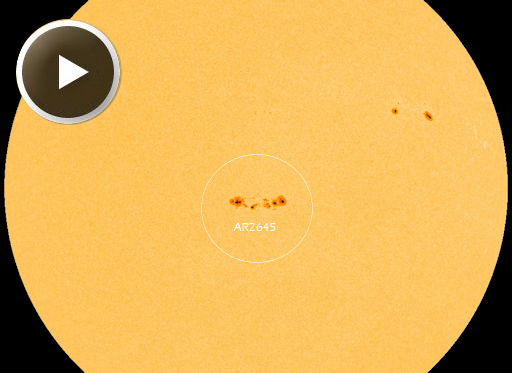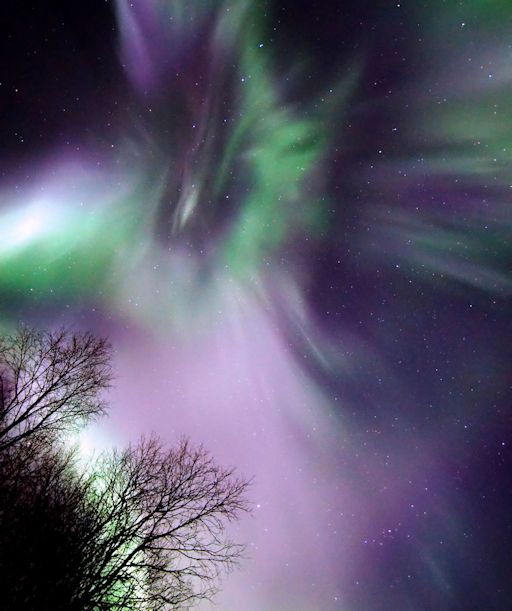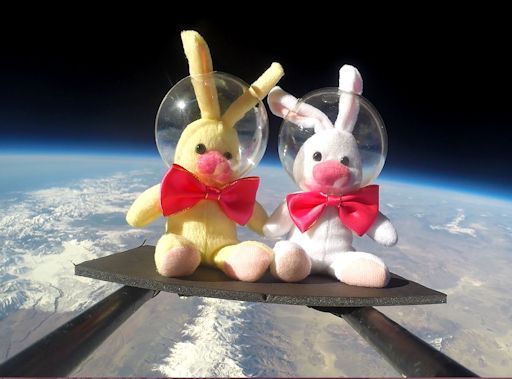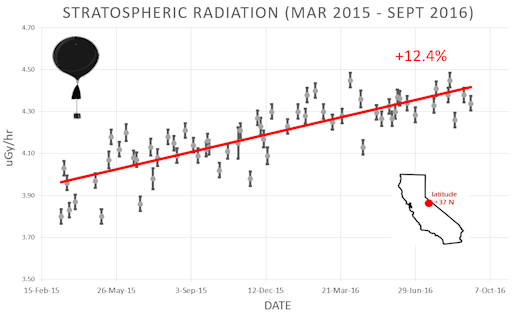Directly under the Arctic Circle! Marianne's Arctic Xpress in Tromsø offers fjord, whale and wildlife tours by day, aurora tours by night. Email Marianne for bookings and availability. | | | APRIL 1ST COMET FLYBY: No kidding. This weekend, green comet 41P/Tuttle-Giacobini-Kresak is flying over Earth's northern hemisphere where sky watchers can find it all night long not far from the bowl of the Big Dipper. At closest approach on April 1st it will be just 21 million km from Earth--an easy target for backyard telescopes and almost visible to the naked eye. [photo gallery] [sky map] [ephemeris] BIG SUNSPOT FACES EARTH: In a year of few sunspots, AR2645 is remarkable. The young spot has quickly grown from an almost invisible speck into a sprawling behemoth more than 120,000 km wide, with multiple dark cores larger than Earth. And, it is directly facing our planet: 
AR2645 has a 'beta-gamma' magnetic field that harbors energy for M-class (moderately strong) solar flares. Any such explosions while the sunspot faces Earth could ionize the top of our planet's atmosphere and alter the normal propagation of radio transmissions around the globe. Shortwave radio blackouts are possible if the sunspot erupts. Despite its potential, AR2645 has so far been quiet, emitting only a crackling of minor C-flares with minimum effect on Earth. NOAA forecasters estimate a 10% chance of more potent M-flares in the next 24 hours. Realtime Space Weather Photo Gallery PINK AURORAS: Earth's solar wind environment remains enhanced 6 days after our planet entered a stream of solar wind flowing from a canyon-shaped hole in the sun's atmosphere. The action of this wind stream is producing intermittent auroras around the poles--including this surge of pink last night in the Finnish Lapland: 
"Just before midnight, suddenly, we saw an enormous outburst of auroras," says photographer B.Art Braafhart. "This pink corona was the highlight of the show." More Arctic auroras are possible in the nights ahead. In addition to the current solar wind stream, another lesser stream is due to arrive in the next 24 hours or so, adding its effect to the gaseous flow now surrounding Earth. NOAA forecasters estimate a 25% to 30% chance of G1-class geomagnetic on April 1st and 2nd. Realtime Aurora Photo Gallery
FLIGHT OF THE EASTERNAUTS: The cosmic ray monitoring program of Spaceweather.com and Earth to Sky Calculus is not supported by government grants or big corporate sponsors. Instead we rely on you. That is, you and the Easternauts: 
On March 2nd, student researchers flew a payload-full of Easter bunnies to the edge of space--and you can have one for $39.95. (Space helmet included!) They make great Easter gifts for young scientists. Each bunny comes with a greeting card showing the Easternaut in flight and telling the story of its journey to the stratosphere and back again. More far-out gifts may be found in the Earth to Sky store. All proceeds support STEM education and our atmospheric cosmic ray monitoring program.
Realtime Comet Photo Gallery
Every night, a network of NASA all-sky cameras scans the skies above the United States for meteoritic fireballs. Automated software maintained by NASA's Meteoroid Environment Office calculates their orbits, velocity, penetration depth in Earth's atmosphere and many other characteristics. Daily results are presented here on Spaceweather.com. On Apr. 1, 2017, the network reported 8 fireballs.
(8 sporadics)  In this diagram of the inner solar system, all of the fireball orbits intersect at a single point--Earth. The orbits are color-coded by velocity, from slow (red) to fast (blue). [Larger image] [movies] Potentially Hazardous Asteroids ( PHAs) are space rocks larger than approximately 100m that can come closer to Earth than 0.05 AU. None of the known PHAs is on a collision course with our planet, although astronomers are finding new ones all the time. On April 1, 2017 there were 1781 potentially hazardous asteroids. Notes: LD means "Lunar Distance." 1 LD = 384,401 km, the distance between Earth and the Moon. 1 LD also equals 0.00256 AU. MAG is the visual magnitude of the asteroid on the date of closest approach. | | Cosmic Rays in the Atmosphere |
Readers, thank you for your patience while we continue to develop this new section of Spaceweather.com. We've been working to streamline our data reduction, allowing us to post results from balloon flights much more rapidly, and we have developed a new data product, shown here: 
This plot displays radiation measurements not only in the stratosphere, but also at aviation altitudes. Dose rates are expessed as multiples of sea level. For instance, we see that boarding a plane that flies at 25,000 feet exposes passengers to dose rates ~10x higher than sea level. At 40,000 feet, the multiplier is closer to 50x. These measurements are made by our usual cosmic ray payload as it passes through aviation altitudes en route to the stratosphere over California. What is this all about? Approximately once a week, Spaceweather.com and the students of Earth to Sky Calculus fly space weather balloons to the stratosphere over California. These balloons are equipped with radiation sensors that detect cosmic rays, a surprisingly "down to Earth" form of space weather. Cosmic rays can seed clouds, trigger lightning, and penetrate commercial airplanes. Furthermore, there are studies ( #1, #2, #3, #4) linking cosmic rays with cardiac arrhythmias and sudden cardiac death in the general population. Our latest measurements show that cosmic rays are intensifying, with an increase of more than 12% since 2015: 
Why are cosmic rays intensifying? The main reason is the sun. Solar storm clouds such as coronal mass ejections (CMEs) sweep aside cosmic rays when they pass by Earth. During Solar Maximum, CMEs are abundant and cosmic rays are held at bay. Now, however, the solar cycle is swinging toward Solar Minimum, allowing cosmic rays to return. Another reason could be the weakening of Earth's magnetic field, which helps protect us from deep-space radiation. The radiation sensors onboard our helium balloons detect X-rays and gamma-rays in the energy range 10 keV to 20 MeV. These energies span the range of medical X-ray machines and airport security scanners. The data points in the graph above correspond to the peak of the Reneger-Pfotzer maximum, which lies about 67,000 feet above central California. When cosmic rays crash into Earth's atmosphere, they produce a spray of secondary particles that is most intense at the entrance to the stratosphere. Physicists Eric Reneger and Georg Pfotzer discovered the maximum using balloons in the 1930s and it is what we are measuring today. | | The official U.S. government space weather bureau | | | The first place to look for information about sundogs, pillars, rainbows and related phenomena. | | | Researchers call it a "Hubble for the sun." SDO is the most advanced solar observatory ever. | | | 3D views of the sun from NASA's Solar and Terrestrial Relations Observatory | | | Realtime and archival images of the Sun from SOHO. | | | from the NOAA Space Environment Center | | | a proud supporter of science education and Spaceweather.com | | | fun to read, but should be taken with a grain of salt! Forecasts looking ahead more than a few days are often wrong. | | | from the NOAA Space Environment Center | | | the underlying science of space weather |  | Beautyz for top beauty products reviews and their buying guides |  | Reviews here can help you to pick up best memory foam mattresses. | | | These links help Spaceweather.com stay online. Thank you to our supporters! | | 
